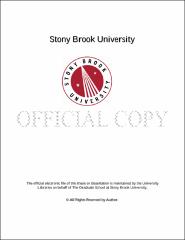| dc.identifier.uri | http://hdl.handle.net/11401/77139 | |
| dc.description.sponsorship | This work is sponsored by the Stony Brook University Graduate School in compliance with the requirements for completion of degree. | en_US |
| dc.format | Monograph | |
| dc.format.medium | Electronic Resource | en_US |
| dc.language.iso | en_US | |
| dc.publisher | The Graduate School, Stony Brook University: Stony Brook, NY. | |
| dc.type | Thesis | |
| dcterms.abstract | In order to improve performance of heterogeneous catalysts used in industrially important processes, it is of critical importance to understand the interfacial electronic properties of adsorbates on solid surfaces. Among various important electronic properties, interfacial charge transfer between the active catalyst and its supporting material can be correlated with the chemical activity of the catalyst for certain reactions. The work presented in this thesis, focuses on the charge transfer and surface dipole study at the interface of metal oxide/sulfide clusters deposited on Cu(111) and metal oxide clusters deposited on a Cu<sub>2</sub>O/Cu(111) film, studied using two-photon photoemission (2PPE) spectroscopy and other surface analysis techniques. These materials represent models for nanocatalysts for alternative fuel production (hydrogen, methanol) through the water-gas-shift reaction and CO<sub>2</sub> hydrogenation. Size-selected metal oxide clusters (Mo<sub>3</sub>O<sub>9</sub>, W<sub>3</sub>O<sub>9</sub>, Ti<sub>3</sub>O<sub>6</sub>, Mo<sub>3</sub>O<sub>6</sub>, W<sub>3</sub>O<sub>6</sub> and Ti<sub>5</sub>O<sub>10</sub>) and metal sulfide cluster (Mo<sub>4</sub>S<sub>6</sub>) have been selectively deposited on Cu(111) surface or a Cu<sub>2</sub>O/Cu(111) film, using a size-selection cluster deposition apparatus. Cluster distribution on the substrate was monitored with Auger electron spectroscopy (AES), and follows a Gaussian distribution within the different cluster-substrate systems. The work function shift due to cluster deposition was measured with 2PPE spectroscopy, which showed a consistent trend of work function increase for all the cluster-substrate systems here. In addition, surface dipoles are derived from work function shift measurement using the Topping model, which provides a method to study the interfacial charge transfer orientation and magnitude. These results suggest strong cluster-substrate interactions that result in interfacial charge transfer that is highly cluster and substrate dependent. | |
| dcterms.available | 2017-09-20T16:52:04Z | |
| dcterms.contributor | Rodriguez, José | en_US |
| dcterms.contributor | White, Michael G | en_US |
| dcterms.contributor | Jia, Jiangyong. | en_US |
| dcterms.creator | Nie, Lizhou | |
| dcterms.dateAccepted | 2017-09-20T16:52:04Z | |
| dcterms.dateSubmitted | 2017-09-20T16:52:04Z | |
| dcterms.description | Department of Chemistry. | en_US |
| dcterms.extent | 60 pg. | en_US |
| dcterms.format | Monograph | |
| dcterms.format | Application/PDF | en_US |
| dcterms.identifier | http://hdl.handle.net/11401/77139 | |
| dcterms.issued | 2013-12-01 | |
| dcterms.language | en_US | |
| dcterms.provenance | Made available in DSpace on 2017-09-20T16:52:04Z (GMT). No. of bitstreams: 1
Nie_grad.sunysb_0771M_11488.pdf: 1775844 bytes, checksum: 7bc461886a569938bedcfa7a95874012 (MD5)
Previous issue date: 1 | en |
| dcterms.publisher | The Graduate School, Stony Brook University: Stony Brook, NY. | |
| dcterms.subject | Physical chemistry | |
| dcterms.title | An Investigation of Charge Transfer at the Cluster-Substrate Interface Using Size-Selected Clusters | |
| dcterms.type | Thesis | |

